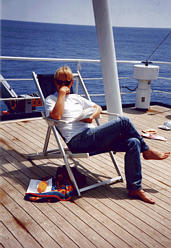
|
Me, on the Italian ship Urania in 1999.
|

|
RRS James Clark Ross, the research ship of the British Antarctic Survey,
in Grytvikan harbour, South Georgia.
|
|
View of James Clark Ross from the back showing the Hawaii-MR1 sonar which was used
to study the Bouvet triple junction
|
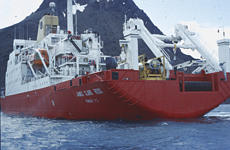
|
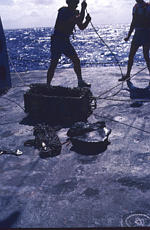
|
Dredging basalt from the ocean floor near Hawaii on the R/V Thomas Washington (formerly of
the Scripps Institution of Oceanography, USA).
|
|
Fixing up the trigger arm of a piston corer on the R/V Thomas Washington. Piston corers are designed
to take samples of sediment by driving a tube into the seabed. The large weight on the right is
released when the weight being hooked up on the left touches the seabed.
|
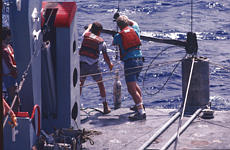
|
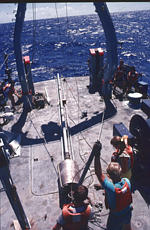
|
Handling the piston corer on deck. Ropes are used to control the core head (large weight)
from the rolling of the ship. |
|
Launching TOBI, a medium range sidescan sonar, from the back of RRS Charles Darwin over the
Mid-Atlantic Ridge. The sidescan sonar transmitters and receivers are
the straight grey blocks on the side of the instrument. The red blocks are formed of a plastic foam for buoyancy.
TOBI stands for "Towed Ocean Bottom Instrument".
|
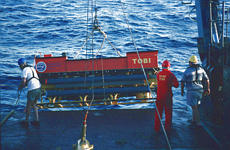
|
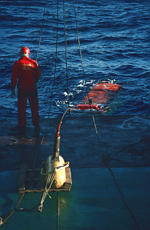
|
... and recovering TOBI from the water. The yellow object in the foreground is a weight
attached to the cable when towing, which has the effect of isolating the sonar mechanically
from the motions of the ship.
|
|
GLORIA, a long-range sidescan sonar of the Southampton Oceanography Centre,
loaded on its gantry on the rear deck of RRS Charles Darwin
(background, the Seychelles Islands). This system was used
to study the Indian Ocean triple junction.
|
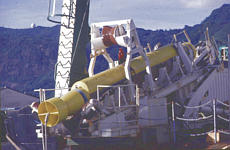
|
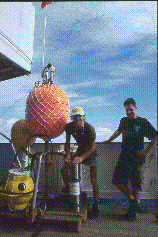
|
Andre and Uli standing next to an ocean bottom seismometer on the FS Meteor in 1999, in a cruise to the Mid-Atlantic Ridge led by Ernst Flueh of GEOMAR.
|



















